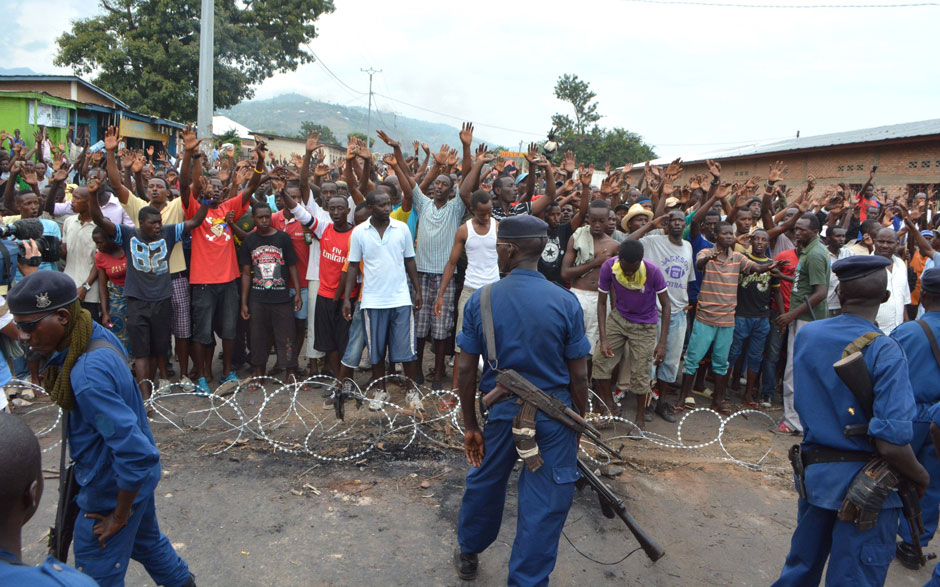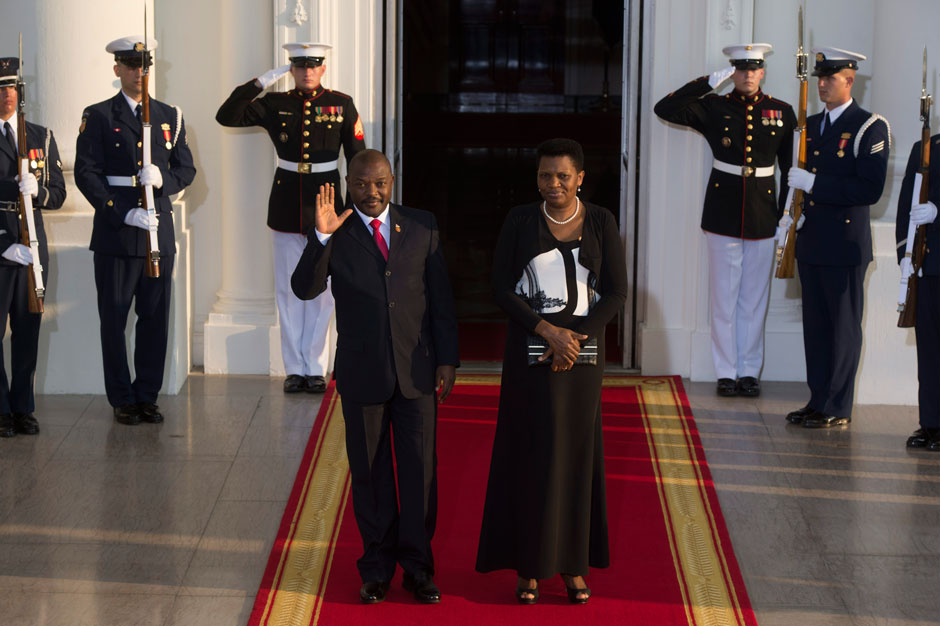Poor Burundi. Landlocked, tiny, and known mainly for ethnic conflict, it was for years the subject of one of the most intense international peace-building efforts in history. By the time the Arusha Peace Agreement was finally signed in 2003, 300,000 Burundians had died in a civil war rivaling in ferocity that of its neighbor Rwanda. Huge sums had been invested in grassroots workshops, high-level meetings and summits to end the fighting. According to Burundi specialist Peter Uvin, taxi drivers in the capital Bujumbura joke that the per diems received during these protracted negotiations built the poshest neighborhood in the city. Now, a decade after the peace process came to what seemed a successful conclusion, and despite billions of dollars in humanitarian aid, the country appears to be falling apart again.
In April, President Pierre Nkurunziza, in power since 2005, announced he’d be running for a third term in elections scheduled for June. Opposition supporters, church leaders, student and civil society groups, much of the international community, and even many in Nkurunziza’s own party say this violates the Arusha agreement, which limits a president to two terms in office. They also accuse Nkurunziza—a former warlord who became a born-again Christian and travels with his own Hallelujah football club and choir—of presiding over a regime of corruption remarkable even by East African standards. Many also claim President Nkurunziza has condoned politically motivated killings of opposition figures and provided tacit government support to an armed militia known as Imbonerakure, which could be deployed to intimidate voters during the election.
Thousands of Burundians took to the streets in mid-April to protest Nkurunziza’s plans to run for office again. Hundreds were arrested and perhaps twenty—the number is disputed—were killed. Security forces were split, with some in the army on the side of the people. On May 13, a group of army officers led by former intelligence chief Godefroid Niyombare announced they’d ousted Nkurunziza, to much rejoicing in Bujumbura. Nkurunziza was in Tanzania discussing the crisis with other African leaders, but he quickly snuck back across the border where he was met by his own forces and retook the capital a couple of days later.
Niyombare is said to be on the run, and most of his fellow coup plotters have been arrested. Three who were wounded were subsequently shot in their hospital beds by men in police uniforms as horrified nurses, doctors, and other patients looked on. An estimated hundred thousand refugees have fled to neighboring countries. The protestors are continuing their demonstrations, while Nkurunziza seems determined to go ahead with his plans to stand for reelection. On Wednesday, Radio France Internationale reported that police in Bujumbura had cordoned off an entire neighborhood and were shooting at anti-third term activists among their homes.
What makes events in this tiny country so important, and so heartbreaking, is that they are part of a recent pattern that actually seemed hopeful. When protest movements swept across the Middle East region—in Iran in 2009 and then in the Arab Spring countries—they didn’t stop at the Sahara desert. In their new book Africa Uprising, Adam Branch and Zachariah Mampilly document more than ninety political protests in forty African countries in the past decade—most in the past six years. Many have had the same aim as those in the Middle East: to force corrupt leaders out of power.
Some have been encouraging: after Senegal’s Constitutional Court ruled—under duress, some say—that President Abdoulaye Wade could run for what many maintained was an unconstitutional third term in the 2012 elections, people poured onto the streets in outrage. Police in riot gear fired tear gas and rubber bullets, and a handful of protesters were killed. But the country’s citizens got their point across. Wade lost the election and conceded defeat.
There’s also cautious optimism about Burkina Faso. When President Blaise Compaoré tried to strongarm the National Assembly into removing term limits so he could contest the 2015 election, hundreds of thousands of people gathered in front of the building while some forced their way in. He was deposed in October 2014, and an interim military council is now organizing elections to take place later this year. And when demonstrators in the Democratic Republic of Congo took to the streets of Kinshasa in January, they managed to halt President Joseph Kabila’s attempt to alter the constitution, which would have extended his term beyond its end date of 2016.
Attempts at tyrant-removal are unlikely to end anytime soon. Over two dozen African countries are headed for elections in the next two years, including Uganda, Rwanda, Ethiopia, South Sudan, and other countries whose leaders have signaled an intention to remain in office no matter what. Protest movements in some of these countries are gathering force, and army commanders are quietly choosing sides between the autocrats and the people.
Advertisement
Why do so many African leaders assume they can ignore their constitutions, cling to power, and get away with it?
In order to understand this epidemic of folly, it’s important to appreciate how much influence the West has over these countries—either through foreign aid given bilaterally, via institutions such as the World Bank, or in the form of clandestine military support. For example, Western aid pays for half of Burundi’s budget, roughly 40 percent of Rwanda’s, 50 percent of Ethiopia’s and 30 percent of Uganda’s . All these countries receive an unknown amount of military aid as well. This money enables African leaders to ignore the demands of their own people, and facilitates the financing of the patronage systems and security machinery that keeps them in power.
The problems started with the debt crisis in the 1970s. African countries that had borrowed and spent lavishly in the years following independence found themselves unable to repay the commercial banks that had lent them money. The Western nations, via the World Bank and International Monetary Fund, took over and restructured these loans, but demanded large public spending cuts. Huge numbers of teachers, nurses, doctors, and other public servants lost their jobs; programs to expand health care and education, improve roads and bring water and electricity to rural areas ground to a halt; poverty deepened; infant mortality rose.
In many cases, the new austerity programs, intended to lead to more efficient government, instead encouraged unprecedented corruption. Those who managed to hold on to government and civil service jobs scrambled to grab whatever they could for themselves and their increasingly dependent extended families. This patronage system helped control dissent, as many African leaders used what Cameroonians term “the politics of the belly”—bribery—to compromise their critics and coopt opposition groups. But it also led to deteriorating public services, as I documented in Uganda, where the maternal mortality rate in the largest referral hospital had increased seven-fold since the days of Idi Amin, according to a World Bank consultant who had worked there in the 1970s.
The continent’s foreign aid donors were not oblivious to these problems. They knew that this new loan regime, known as Structural Adjustment, would hurt huge numbers of people. For example, in a notorious 1981 World Bank report about the program , the authors acknowledge that some reforms would be resisted by “consumers and producers, parastatal managers, civil servants and industrialists,”—meaning just about everybody in the nations involved. The state had to be “willing to take strong action on internal problems,” the report continued. As Branch and Mampilly note, many African scholars interpreted this as tacit donor permission for repression in countries receiving loans. This would be consistent with the donors’ tendency to look the other way when Adjustment-friendly leaders—like Burkina Faso’s Compaoré, Cote D’Ivoire’s Félix Houphouët-Boigny, Uganda’s Museveni and Kenya’s Daniel Arap Moi—jailed, murdered, or exiled their critics. The donors’ tolerance for human rights abuses may help explain why, when ethnic discrimination and repression escalated into genocide, as it did in Rwanda and Burundi, the international community did nothing until it was far too late.
Another reason so many African leaders feel they can afford to ignore their own people has to do with America’s “War on Terror.” During the 1990s, the Clinton administration began securing military ties with African leaders who seemed willing to cooperate in the fight against what Clinton officials saw as the rising threat of Islamic militancy on the continent. These ties have only grown in the years after September 11. According to journalist Nick Turse, the US military has sponsored more than one thousand African missions since 2011, with countries such as Nkurunziza’s Burundi, along with Rwanda, Ethiopia, Chad, and Uganda, deploying troops and guards across Africa and the Middle East at America’s behest. The primary purpose of this seems to be to monitor and prevent the emergence of terrorist groups in weak states. But it’s no coincidence that the US’s military allies in Africa have often used security forces against their own critics at home. As the events in Burundi suggest, providing support to ugly regimes may ultimately undermine the very stability we are supposedly seeking.
Now, fed up with decades of lies, plunder and abuse, Africans across the continent are finally rising up to challenge these Western-backed thugs. Some have been inspired by protests elsewhere in the world; some are united in new ways by Facebook, Twitter, and chat programs. Foreign aid has also brought thousands of NGOs into Africa. Not all are effective, but their American and European employees and volunteers have, naively or not, exposed African people to liberal Western attitudes and ideals of human rights as never before.
Advertisement
Branch and Mampilly lament that whereas past African protest movements had clear ideologies, like Independence, African Nationalism and Pan-Africanism, the only thing today’s protesters appear to want is the removal of the current leadership of their countries. But this lack of a grand objective may not be such a bad thing, as long as whoever takes over pursues a modest program of obeying the rule of law, eschewing corruption and respecting human rights. This is why this spring’s election in Nigeria, in which incumbent Goodluck Jonathan graciously conceded defeat, was so welcome. Some opposition supporters had threatened violence if it felt the election was rigged, but this proved unnecessary. Though Nigeria’s new leader, former General Muhammadu Buhari, behaved like a tyrant when he briefly ruled the country between 1983 and 1985, he also cracked down on corruption. For two years, Nigerians formed orderly lines at bus stops, the streets were clean, and politicians didn’t steal. Many Nigerians, exasperated with their supremely corrupt country, are hoping for a spell of modest probity, as long as Buhari honors his promise to respect human rights this time. If we’re seeing the dawn of a new movement, let’s forgive it for lacking a glamorous label. Right now, it’s the best hope this beleaguered continent has.
Adam Branch and Zachariah Mampilly’s Africa Uprising: Popular Protest and Political Change is published by Zed Books and distributed by the University of Chicago Press.




